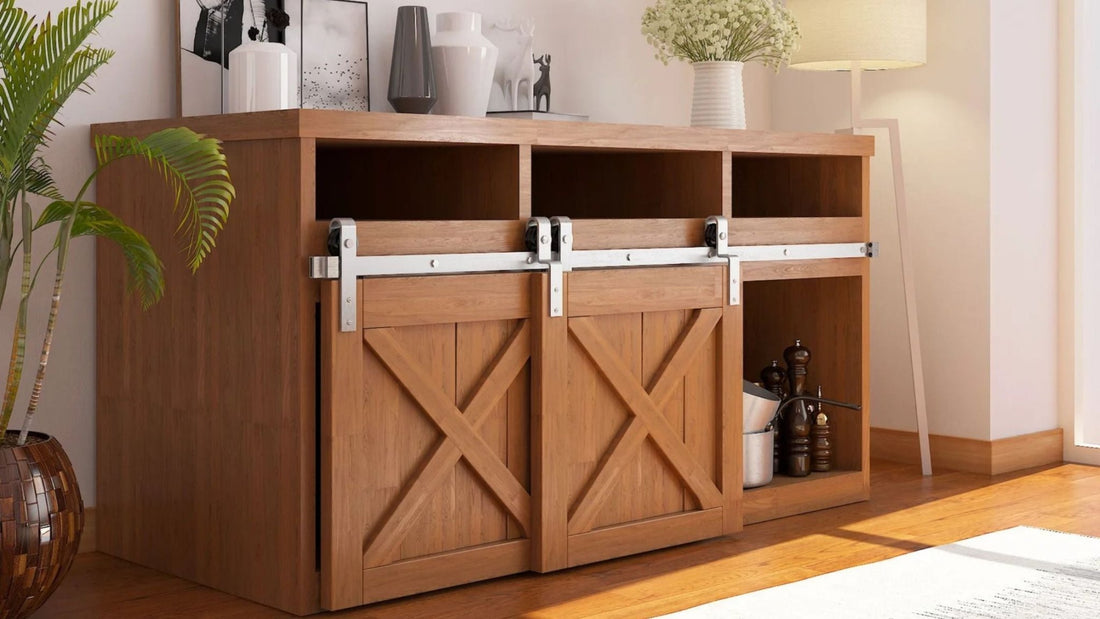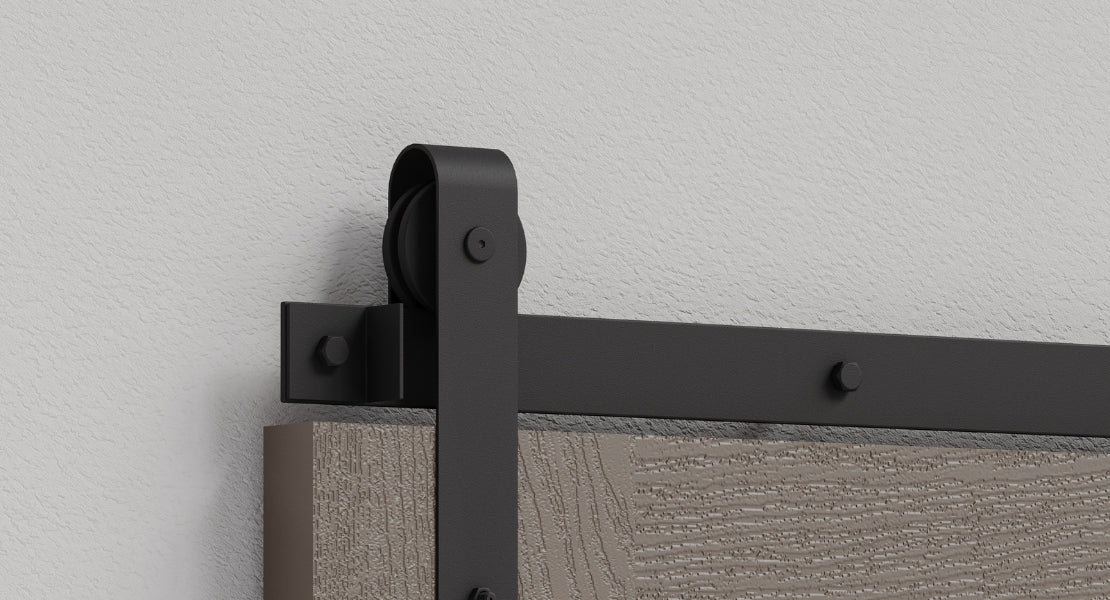
Small Space Barn Door Solutions: Mini Hardware for Cabinets, Pantries & Tight Spaces
Think barn doors are only for full-size rooms? Think again.
While everyone's focused on grand sliding doors that make dramatic statements in living rooms and bedrooms, there's a whole world of mini barn door applications that are quietly revolutionizing small spaces everywhere.
Whether you're dealing with a tiny apartment where every square inch matters, an RV where traditional doors simply won't work, or you just want to add barn door charm to unexpected places, mini hardware solutions are opening up possibilities you never considered.
The beauty of small-scale barn door hardware is that it brings all the style and functionality of full-size systems to spaces that traditional doors can't handle.
We're talking about cabinet makeovers, entertainment center concealment, creative storage solutions, and tiny home applications that prove great design truly comes in all sizes.
What makes mini barn doors different
Mini barn door hardware operates on the same sliding principles as full-size systems, just scaled down for lighter applications and tighter spaces.
We're typically talking about doors ranging from 12 to 48 inches wide, with hardware designed to support 25-50 pounds instead of the 200+ pound capacity of standard systems.
The track systems are proportionally smaller—usually around 1 inch thick compared to 1-1/2+ inches for full-size hardware—and all the components from rollers to mounting brackets are engineered for the lighter loads and more frequent operation common in small-space applications.
The applications are surprisingly diverse: Kitchen and bathroom cabinets get instant character upgrades. Entertainment centers hide TVs and media equipment stylishly. Pantries and storage closets maximize accessibility in tight quarters. RV and tiny home owners solve space constraints that make traditional doors impossible.
What makes mini barn doors particularly appealing is their ability to solve real functional problems while adding unexpected style.
They're perfect for spaces where swinging doors would hit walls, furniture, or each other, and they offer accessibility advantages for people who find traditional cabinet doors awkward to operate.
Cabinet applications: small changes, big impact

Kitchen cabinets are probably the most popular mini barn door application, and for good reason. Those upper cabinets above your sink or stove?
Perfect candidates for a barn door makeover that adds character while maintaining full functionality.
The transformation is surprisingly simple.
Remove the traditional hinged doors, install mini track hardware to the cabinet frame, and mount your new sliding doors. The result is an instant focal point that can turn builder-grade cabinets into custom-looking features.
Upper cabinets work exceptionally well because you can create that trendy open-shelving look when doors are slid open, while still having the option to conceal contents when needed. It's particularly effective for displaying nice dishware or glassware that you want to show off sometimes, but keep dust-free other times.
Lower cabinet applications offer different advantages. Think about that awkward corner cabinet where traditional doors always seem to be in the way, or base cabinets where you want to conceal small appliances like coffee stations. Mini barn doors can slide entirely out of the way, giving you full access to contents without fighting door swing limitations.
Bathroom vanities are another sweet spot for mini barn door hardware. Under-sink storage traditionally hidden behind awkward hinged doors becomes easily accessible with sliding doors. Plus, you can incorporate features like integrated towel bars or hooks right into the door design.
Entertainment centers and media solutions

Nothing dates a room quite like a big black TV screen dominating the wall when it's not in use. Mini barn doors offer an elegant solution that's become increasingly popular as wall-mounted TVs have become the standard.
The concept is beautifully simple: install mini track hardware above your TV and create sliding doors that can conceal the screen completely when not in use. When you want to watch, the doors slide aside and park neatly to one side. When you're done, slide them closed, and you have a clean wall that can display artwork, family photos, or just blend seamlessly with your decor.
Built-in entertainment centers take this concept further. Those open shelving units filled with gaming consoles, cable boxes, and DVD collections can get barn door treatments that organize and conceal the visual clutter while maintaining easy access to everything.
The design possibilities are endless. Reclaimed wood gives an authentic rustic feel that works beautifully in farmhouse or industrial spaces. Painted MDF creates clean, modern lines perfect for contemporary homes. You can even use chalkboard paint to turn entertainment center doors into family message centers or kids' art spaces.
Small space and tiny home applications
For tiny home and RV owners, mini barn doors aren't just stylish—they're often essential solutions to space constraints that make traditional doors impossible.
Tiny home bathrooms are a perfect example. In a space where every inch counts, a traditional hinged door might interfere with fixtures, storage, or walking space. A mini barn door can slide entirely out of the way, effectively "disappearing" when open, while still providing full privacy when closed.
RV applications are equally compelling. Interior doors in RVs need to function in spaces that shift and move, often with limited ceiling height and unusual proportions. Mini barn door hardware can be adapted to these unique constraints while adding style that transforms generic RV interiors into custom-feeling spaces.
Studio apartments benefit from mini barn doors as room dividers and privacy screens. A well-placed sliding door can section off sleeping areas from living spaces, or create a dedicated work-from-home zone that can be opened up when not needed.
The weight advantage is significant, too. Mini barn doors are typically much lighter than traditional doors, which matters in structures designed for mobility or where every pound counts toward weight limits.
DIY vs professional solutions
The mini barn door market offers options for every skill level and budget, from clever DIY solutions to engineered commercial hardware.
DIY enthusiasts have discovered creative alternatives using components like plastic garden edging as track systems—budget-friendly solutions that work for lightweight applications. Others repurpose hardware store components like eye hooks and copper pipe to create custom systems with authentic character.
The DIY route offers complete customization and significant cost savings, but it requires time, experimentation, and realistic expectations about durability. It's perfect for light-duty applications, temporary installations, or when you need unusual sizing that commercial products don't offer.
Commercial mini hardware kits typically run $50-150 for complete systems and offer the advantage of proper engineering, smooth operation, and often include features like soft-close mechanisms and adjustable components. The quality difference is immediately apparent in daily use—smooth, quiet operation that holds up to repeated use.
Choose DIY when you're working with very light doors (under 25 pounds), need custom sizing, or are treating this as a fun experimental project. Go commercial when the doors will see daily use, professional appearance matters, or you're dealing with heavier doors that need reliable hardware.
Installation and troubleshooting tips
The most common mistake in mini barn door installations is inadequate clearance planning. Remember that your door needs to overlap the opening by at least 1-2 inches on each side for proper coverage, and the track needs to be at least twice the door width to allow full opening.
Measuring is critical: For the door—opening width plus 2-4 inches for overlap. For the track—minimum door width times two if you want the door to park completely clear of the opening.
Weight capacity should always exceed your door weight by at least 50%. A 40-pound door should use hardware rated for at least 60 pounds. This safety margin accounts for the dynamic forces during operation and ensures long-term reliability.
Common troubleshooting: Sticking usually means track misalignment or insufficient lubrication. Sagging indicates inadequate mounting or exceeded weight limits. Noise problems typically come from dry rollers or worn components that need replacement.
Making small spaces work better
Mini barn doors represent something larger happening in home design—the recognition that small spaces deserve the same attention to style and functionality as grand rooms. They prove that creative solutions can solve real problems while adding unexpected character.
Whether you're transforming a single cabinet, concealing a TV, or reimagining storage throughout a tiny home, mini barn door hardware opens up possibilities that traditional doors simply can't match. The best installations solve genuine functional problems while adding that touch of rustic charm that makes spaces feel more custom and intentional.
Conclusion
Don't let small spaces limit your design potential. Mini barn door hardware brings all the style and functionality of full-size systems to tight quarters where traditional solutions fall short.
Start with one simple application—maybe that cabinet that's always bothered you, or that entertainment center that never looks quite right. You might be surprised at how much character and functionality you can add with just a few square feet of sliding door magic.
The Barn Door Hardware Store offers complete mini barn door solutions—from lightweight cabinet hardware to heavy-duty small-space systems.
Our mini hardware collection is designed specifically for tight quarters and frequent use, backed by our limited lifetime warranty and detailed installation guidance for perfect small-space transformations.


